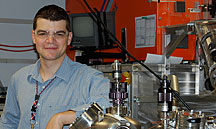- Number 300 |
- November 23, 2009
Maksymovych delves into 'completely different' ferroelectrics

Petro Maksymovych
Leaving his Ukraine roots destined for the United States to pursue a scientific career, Petro Maksymovych had little idea of the abundance of possibilities he would encounter.
“One of the things I wanted was to do something completely different than what I did as a graduate student,” he says.
He is succeeding. Maksymovych and his colleagues at DOE's Oak Ridge National Laboratory have turned their attention to ferroelectric oxides, which are unique in that their structure is correlated in such as way as to produce spontaneous polarization. that can be reversed by applying electric field. The stability and non-volatility of spontaneous polarization have made ferroelectrics ubiqitous in portable memory devices such as such as RFID cards in the form of FeRAM (Ferro-electric Random Access Memory.) On the fundamental side, ferroelectricity is a key component of multiferroic behavior, where spontaneous polarization is coupled to strain and magnetization.
It was hypothesized years ago that spontaneous polarization can control the electronic conductance of the ferroelectric oxide. This archetypal property would enable ultra-high density information storage in nanoscale ferroelectric materials, and “it is also a stepping stone to a broad range of novel phenomena arising from coupling of soft-phonon order parameters to electron transport,” Maksymovych says. The problem, he says, is that these materials are practically insulators—"you can’t run current across them. One way out is to shrink them down—but then you lose the polarization property and with it memory functionality."
Maksymovych and his colleagues working in ORNL's Center for Nanophase Materials Sciences have found a way around that: “You don’t necessarily need to shrink it down. All you have to do is [use] a somewhat leakier medium. That will give you access to the interface, where ferroelectricity will manifest itself the most.”
"These ‘leaky’ thin films are usually avoided due to their interference with other measurements, like polarization. To avoid the problem, the researchers have assumed a new approach based entirely on scanning probe microscopy.
“Macroscopic measurements have little means to differentiate intrinsic and extrinsic behaviors. Our approach, by virtue of its low-dimensional design, lets us identify the intrinsic properties and resolve their variation across the surface. If we so desire, we can subsequently go and find defects in the material to see what influence they have on the intrinsic properties, or whether they dominate them,” Maksymovych says.
The new approach is anticipated to affect much more than electronic applications.
“We are very excited by this very first step. We are confident that the intriguing atomistic and electronic dynamics of multiferroics will bring in a new dimension in the physics of these materials with future relevance to both energy and information,” Maksymovych says.
He earned a B.S. in chemistry from the Kiev Tara Shevchenko University in Ukraine and graduated from the University of Pittsburgh with a doctorate in physical chemistry. He arrived at ORNL in 2007 as a Eugene P. Wigner Fellow.
Since arriving at ORNL, Maksymovych has already authored or co-authored a number of papers in major peer-reviewed journals. In addition to oxide materials, he is currently working on a new intiative at the Center for Nanophase Materials Sciences, focused on chemical dynamics and electronic properties of single molecules and molecular assemblies.
Maksymovych still finds time to dabble in activities outside of work, such as playing with the latest computer technology going hiking, attending underground musical theaters and learning how to play guitar, “a major affection.”
—Kathyrn Baddorf and Joanna Finney, contributors
Submitted by DOE's Oak Ridge National Laboratory
